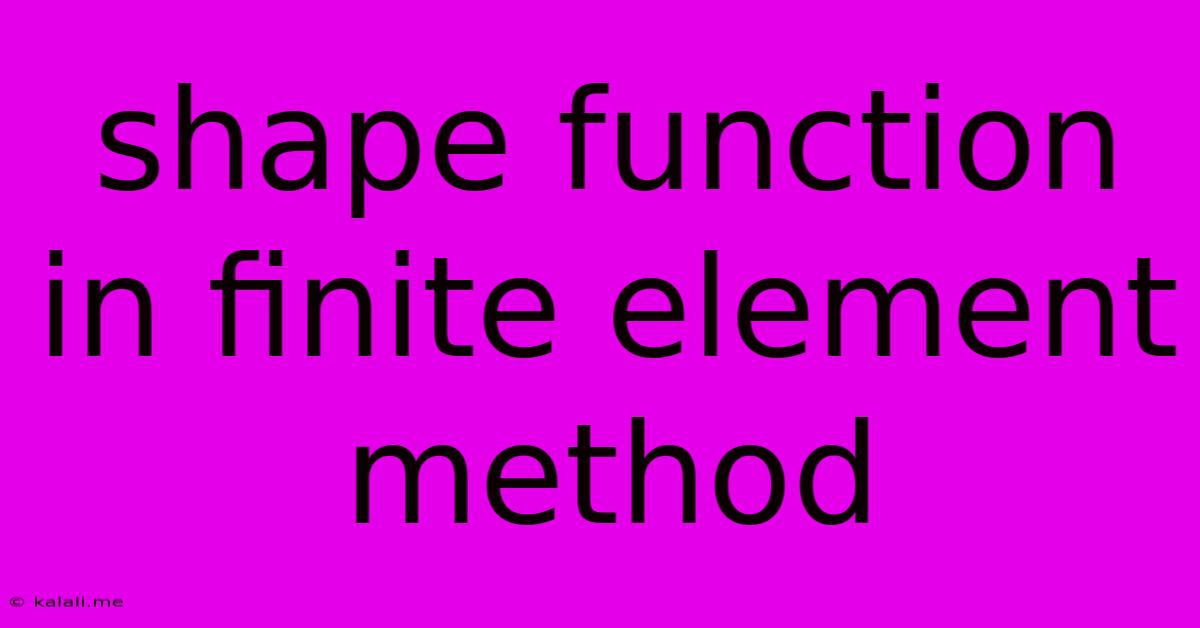Shape Function In Finite Element Method
Kalali
Jun 08, 2025 · 3 min read

Table of Contents
Shape Functions in the Finite Element Method: A Comprehensive Guide
Meta Description: This article provides a comprehensive understanding of shape functions in the Finite Element Method (FEM), explaining their role, types, and importance in numerical analysis. Learn about Lagrange, Serendipity, and Hermite shape functions with clear examples.
The Finite Element Method (FEM) is a powerful numerical technique used to solve complex engineering and physics problems. At its core lies the concept of shape functions, which are crucial for approximating the solution within each element. This article delves into the world of shape functions, explaining their role, different types, and significance in achieving accurate and efficient FEM simulations.
What are Shape Functions?
Shape functions, also known as interpolation functions or basis functions, are mathematical functions used to interpolate the solution within an element. They define how the solution varies within each element based on the nodal values. Essentially, they create a continuous approximation of the solution across the entire domain by combining the contributions from each element. This approximation is crucial because FEM transforms a complex, continuous problem into a series of simpler, discrete problems solvable through matrix algebra.
Imagine you have a simple element – a line, triangle, or tetrahedron – with nodes at its vertices. The shape function associated with a particular node will have a value of 1 at that node and 0 at all other nodes within the element. This property allows for the accurate representation of the solution at each node and a smooth transition between elements.
Types of Shape Functions
Several types of shape functions exist, each suited to different element types and problem complexities:
1. Lagrange Shape Functions: These are the most common type of shape functions, primarily used for elements with only nodal values as degrees of freedom. They are polynomial functions that satisfy the Kronecker delta property – φᵢ(xj) = δᵢⱼ, where φᵢ is the shape function for node i, and xj represents the coordinates of node j. This means the shape function for a particular node is 1 at that node and 0 at all other nodes.
* **Linear Lagrange functions:** Used for linear elements (e.g., 2-node line element, 3-node triangular element). Simple and computationally efficient but less accurate for complex problems.
* **Quadratic Lagrange functions:** Used for quadratic elements (e.g., 3-node line element, 6-node triangular element). Offer improved accuracy compared to linear elements.
* **Higher-order Lagrange functions:** Employ polynomials of higher degree to achieve greater accuracy but increase computational complexity.
2. Serendipity Shape Functions: Similar to Lagrange functions, but they have fewer nodes than their Lagrange counterparts of the same order. This reduces the number of unknowns in the system of equations, leading to computational efficiency. They are often preferred for quadrilateral and hexahedral elements.
3. Hermite Shape Functions: These shape functions incorporate not only nodal values but also their derivatives (e.g., slopes) as degrees of freedom. They're particularly useful when high accuracy is needed in representing the solution's gradients, such as in beam bending problems where the curvature is important.
Importance of Shape Functions in FEM
The choice of shape function significantly impacts the accuracy and efficiency of the FEM solution. Key aspects include:
- Accuracy: Higher-order shape functions generally provide greater accuracy by capturing more detail in the solution. However, this comes at the cost of increased computational expense.
- Convergence: As the mesh is refined (element size decreases), the solution obtained using appropriate shape functions should converge towards the true solution. This convergence rate is influenced by the order of the shape functions.
- Computational Cost: Lower-order shape functions are computationally cheaper but may require finer meshes to achieve the same level of accuracy as higher-order functions.
Conclusion
Shape functions are fundamental to the Finite Element Method. Understanding their properties, types, and implications is essential for successfully implementing and interpreting FEM simulations. The choice of appropriate shape functions involves balancing accuracy, computational cost, and the specific requirements of the problem being solved. Selecting the right shape function is a critical step in ensuring the accuracy and efficiency of your Finite Element Analysis.
Latest Posts
Latest Posts
-
A Woman Shall Leave Her Home Bible Verse
Jun 08, 2025
-
Find Ip Address Of Salesforce Org
Jun 08, 2025
-
Fix The Shelf In The Kitchen
Jun 08, 2025
-
When Does A Router Use Arp
Jun 08, 2025
-
Will Flour Put Out A Fire
Jun 08, 2025
Related Post
Thank you for visiting our website which covers about Shape Function In Finite Element Method . We hope the information provided has been useful to you. Feel free to contact us if you have any questions or need further assistance. See you next time and don't miss to bookmark.